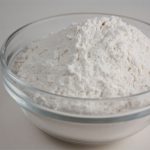 The poet John Keats died in the flower of his youth; Sir Lancelot was the flower of chivalry; Shakespeare’s plays are the flower of English drama. This use of flower to mean the blossom or best part of something is where flour—the best part of the grain after it has been milled and sifted—gets its name. This ground grain sense of flower arose in the mid thirteenth century and existed along side its blossom sense for five hundred years; it was only in the eighteenth century that people started to distinguish the milled-grain flower from the blossom flower by spelling the former word flour. The ultimate source of flower—and therefore also of flour—was an Indo-European word pronounced something like bhlo. When this word entered the Latin and Germanic language families it developed in two different directions: in Latin it became flos, the source of words such as flower, flour, floral, and flourish; in the Germanic language family it became blomon, the source of words such as bloom, blossom, and even blade. At your next dinner party, therefore, you may be arm’s length from three very different items—the flour in the bread, the blade of your knife, and the blossoms in the centre-piece—whose names all derive from a single, ancient source.
The poet John Keats died in the flower of his youth; Sir Lancelot was the flower of chivalry; Shakespeare’s plays are the flower of English drama. This use of flower to mean the blossom or best part of something is where flour—the best part of the grain after it has been milled and sifted—gets its name. This ground grain sense of flower arose in the mid thirteenth century and existed along side its blossom sense for five hundred years; it was only in the eighteenth century that people started to distinguish the milled-grain flower from the blossom flower by spelling the former word flour. The ultimate source of flower—and therefore also of flour—was an Indo-European word pronounced something like bhlo. When this word entered the Latin and Germanic language families it developed in two different directions: in Latin it became flos, the source of words such as flower, flour, floral, and flourish; in the Germanic language family it became blomon, the source of words such as bloom, blossom, and even blade. At your next dinner party, therefore, you may be arm’s length from three very different items—the flour in the bread, the blade of your knife, and the blossoms in the centre-piece—whose names all derive from a single, ancient source.
Finely ground meal obtained from wheat or other grain; any soft fine powder.
The act of coating or wrapping food with flour is commonly known as dredging.
A finely pulverized, pure white substance produced from grains such as corn, rice, or wheat, is referred to as flour. Typically, when the word “flour” is used, it implies wheat flour obtained by grinding the wheat grain. This component is a staple in most moderate climatic regions, and its versatility allows it to be used in an array of consumables, such as bread, cookies, biscuits, pastry, cakes, pasta, and pudding. Additionally, flour is an essential ingredient used to thicken soups, gravies, and sauces.
